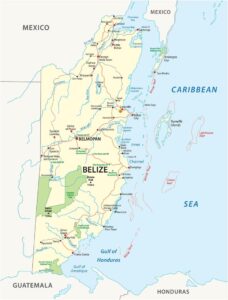Over the centuries, the territorial boundaries of Belize have been influenced by a rich and complex historical narrative. You might find yourself pondering the reason why the border between Belize and Guatemala is often illustrated as dotted on various maps; this visual representation encapsulates a long-standing territorial dispute. This persistent conflict traces back to historical claims made by Guatemala, which has consistently contested Belize’s sovereignty since the latter attained independence. The potential for international discord remains substantial, as both countries are actively involved in diplomatic efforts aimed at resolving this boundary issue. Your journey into this geopolitical conundrum unveils the intricate challenges surrounding national borders in Central America, where colonial legacies interweave with concepts of territorial integrity in potentially volatile manners.
Unpacking the Historical Claims Underpinning the Belize-Guatemala Dispute
The enduring territorial conflict between Belize and Guatemala can be traced back to intricate historical and colonial legacies. This dispute has its roots in the colonial era, where territorial borders were frequently defined vaguely and were open to interpretation. The unresolved border issue has persisted for centuries, resulting in ongoing tension between these two neighbouring nations and influencing their diplomatic relations significantly. The historical context of the conflict highlights how past events continue to shape modern political landscapes and create challenges for both nations as they navigate their relationship amidst competing narratives.

Delving into Guatemala’s Historical Territorial Claims Over Belize
Primarily, Guatemala has consistently upheld a historical assertion of territorial rights over Belize, stemming from the administrative boundaries established during Spanish colonial rule. It may surprise you to learn that Guatemala views Belize as an integral part of its original territorial inheritance from the Spanish Empire, thereby challenging the modern borders that emerged during the time of British colonial governance. This historical perspective continues to inspire Guatemala’s claims and complicates the issue of sovereignty, as it brings forth questions about legacy, identity, and national integrity.
Understanding the Broader Implications of Historical Borders
Since the colonial period, these disputed boundaries have created significant geopolitical complexities for both nations. You can observe how ambiguous border regions can foster conflict and diplomatic tensions, affecting local communities and their sense of national identity. Grasping the nuances of the border dispute reveals multilayered historical, legal, and territorial dynamics. The implications extend beyond mere geographical delineations, encompassing economic, cultural, and security risks. The ongoing conflict carries substantial consequences for regional stability, international law, and the prospects for future negotiations between Belize and Guatemala, highlighting the urgent need for resolution.
The Importance of the Dotted Line in Cartographic Representations
On various maps, you may notice a distinctive feature: a dotted boundary line separating Belize from Guatemala, symbolising an unresolved territorial dispute that has endured for decades. This particular cartographic representation serves as a signal of a complex geopolitical challenge, where the exact border remains undefined and contested. The dotted line not only signifies ongoing diplomatic tensions but also highlights the unsettled territorial claims that have characterised the relationship between these two Central American nations for many years, serving as a constant reminder of the need for resolution.
International Recognition Amidst the Unresolved Border Dispute
In the realm of international relations, Belize is acknowledged as a sovereign state with a recognised international presence; however, the disputed border with Guatemala introduces a nuanced geopolitical scenario. You might find it intriguing that while Belize gained independence in 1981, Guatemala has historically endeavoured to undermine its territorial integrity. The dotted line not only represents geographical ambiguity but also signifies an ongoing diplomatic negotiation that continuously influences regional relations and perceptions, reflecting the complexities inherent in territorial disputes.
The Diplomatic Weight of the Dotted Line
Beyond its representation on maps, the dotted line serves as a significant diplomatic symbol. You can interpret it as a visual embodiment of unresolved territorial claims, signalling to the international community the intricate negotiations between Belize and Guatemala. This unique border marking conveys the ongoing dialogue and the potential for a peaceful resolution to the conflict. However, the dotted line represents more than a mere cartographic curiosity; it embodies a delicate diplomatic instrument that helps avert potential military escalation while maintaining an open channel for dialogue.
This boundary acts as a strategic buffer, allowing both nations to safeguard their diplomatic relations and strive for a possible future resolution. Its existence exemplifies how international borders can be managed through peaceful means, showcasing a sophisticated approach to territorial disputes that prioritises dialogue rather than confrontation.

Examining Key Conflicts and Diplomatic Agreements Between Belize and Guatemala
The territorial disputes between Belize and Guatemala are deeply rooted in history and characterised by complex diplomatic tensions and unresolved boundary claims. You’ll discover that the ongoing disagreement revolves around competing interpretations of colonial-era treaties and the principles of territorial sovereignty. This dispute has extensive implications for both countries, involving potential land ownership challenges and regional geopolitical dynamics that continue to shape their relationship in profound ways.
The Consequences of the 1859 Treaty and Its Aftermath
Prior to the signing of the 1859 treaty between Britain and Guatemala, territorial boundaries within the region were ambiguous and fiercely contested. It’s essential to grasp that this agreement aimed to delineate clear borders; yet, subsequent interpretations have led to ongoing disputes. Guatemala consistently questions the validity of the treaty, claiming that Britain failed to fulfil specific commitments regarding infrastructure development, which has evolved into a fundamental point of contention in their territorial disagreement.
International Court of Justice Involvement and Recent Diplomatic Endeavours
Recent diplomatic initiatives have focused on resolving the long-standing border dispute through international legal frameworks. You’ll note that both nations have reached an agreement to submit their case to the International Court of Justice (ICJ) for a binding resolution. This approach signifies a pivotal step towards peaceful conflict resolution and the potential normalisation of bilateral relations.
In addition to the ICJ proceedings, you should acknowledge the intricate diplomatic negotiations that have unfolded. The potential referendum in both countries to validate the ICJ’s decision represents a unique method for resolving territorial disputes. Your understanding of this process highlights the delicate diplomatic efforts to maintain regional stability and resolve historical territorial claims through peaceful, internationally recognised avenues.
Assessing the Current Situation and Travel Considerations
Many travellers are captivated by Belize’s distinctive border arrangement with Guatemala. The ongoing territorial dispute has created a multifaceted geopolitical landscape that influences travel and border crossings. Despite the prevailing tensions, tourists continue to explore both countries, carefully navigating the intricate diplomatic situation while considering international boundaries and local regulations.
Essential Guidelines for Safe Border Crossing
When planning international travel to Belize, it’s crucial to prepare thoroughly and take these important guidelines into account:
- Ensure you possess a valid passport and any requisite travel documents
- Check the current state of diplomatic relations prior to embarking on your journey
- Secure appropriate travel insurance for your trip
- Remain informed about border crossing procedures to prevent complications
The most vital aspect is to maintain awareness of your surroundings and respect local regulations to guarantee a smooth travel experience, allowing you to enjoy the rich culture and beauty of both nations without unnecessary concern.
Community Perspectives and Local Sentiments Regarding the Dispute
Behind the border dispute lie deep-seated historical tensions and intricate cultural dynamics. Communities located near the border experience the direct effects of the dispute, with generational memories of conflict profoundly influencing their viewpoints. Residents often navigate a delicate balance between national pride and a desire for peaceful coexistence, underscoring the human element in this geopolitical issue.
Gaining Deeper Insights into Local Community Dynamics
To truly appreciate the local perspective, you should delve into the nuanced landscape of cultural identity. You’ll discover that border communities have developed unique survival strategies, melding resilience with diplomatic pragmatism. Indigenous groups, in particular, play a vital role in fostering cross-border relationships, frequently transcending official diplomatic tensions through grassroots connections and shared cultural experiences, thus nurturing a sense of unity amidst conflict.

Future Implications of the Belize-Guatemala Border Dispute
Despite the ongoing territorial dispute, there exists a potential for notable geopolitical shifts. The unresolved border issue between Belize and Guatemala continues to cultivate tension, with implications that could reshape diplomatic relations in Central America. You might observe that resolving this dispute could have profound impacts on regional stability, economic cooperation, and the international perceptions of both nations, opening new avenues for collaboration and mutual growth.
Ongoing Dialogue Between Belize and Guatemala
Dialogue remains the foremost mechanism for addressing the territorial disagreement. You will find that both countries have engaged in diplomatic negotiations, striving for peaceful resolutions through international platforms like the Organization of American States (OAS). These discussions represent a commitment to avoiding military confrontation and discovering a mutually agreeable solution to their long-standing border dispute, highlighting the importance of dialogue in resolving conflicts.
Exploring Viable Pathways Towards Resolution
Above all, you should recognise that numerous strategies exist for resolving the border conflict. International mediation and bilateral negotiations offer potential pathways for progress. You might envision approaches such as joint territorial management, referendums, or interventions from international courts as effective methods to address the dispute comprehensively.
The implications of resolving the conflict extend far beyond mere border demarcation. You will uncover that successful negotiations could unlock substantial economic opportunities for both Belize and Guatemala. Potential benefits may include enhanced trade, improved cross-border cooperation, and increased foreign investment. The most transformative outcome would be establishing permanent territorial sovereignty, which could drastically diminish regional tensions and promote long-term stability in Central America.
Understanding the Regional Dynamics of the Belize-Guatemala Conflict
Unlike other border disputes in Central America, the Belize-Guatemala territorial conflict is steeped in deep historical complexities that have significantly shaped regional geopolitical interactions. You’ll find that this longstanding disagreement reflects broader patterns of territorial tension, encompassing colonial legacies, post-independence territorial claims, and intricate diplomatic negotiations that have profoundly influenced the political landscape of the region.
The Impact of the Dispute on Central American Relationships
After decades of territorial disputes, you can observe how this conflict has strained diplomatic relationships between Belize and Guatemala. The ongoing tension has periodically disrupted regional cooperation, creating challenges for economic integration and mutual understanding within the broader Central American community, highlighting the need for collaborative efforts to foster peace and stability.
The Role of International Organisations in Mediation Efforts
With diplomatic mediation playing a pivotal role, international organisations have actively participated in efforts to resolve the border dispute. You’ll notice that entities like the Organization of American States (OAS) have been instrumental in facilitating dialogue and proposing viable resolution strategies, showcasing the significance of external support in addressing complex geopolitical issues.
A comprehensive network of international organisations has been strategically involved in tackling the Belize-Guatemala border dispute. The United Nations, OAS, and various diplomatic channels have diligently worked to avert escalation, providing mediation services and promoting peaceful negotiations. You’ll appreciate how these organisations have contributed to maintaining stability, offering a structured approach to resolving territorial disagreements while mitigating potential military confrontations.
Reflecting on the Multifaceted Nature of the Belize-Guatemala Border Dispute
Weaving together the intricate threads of Belize’s territorial history, you can observe how the nation’s border with Guatemala stands as a testament to unresolved colonial legacies. As you delve into this geopolitical puzzle, you’ll recognise that the dotted border represents more than a mere cartographic curiosity; it embodies ongoing diplomatic negotiations and historical tensions. Your awareness of this dispute reveals the intricate challenges facing post-colonial states, where territorial boundaries continue to ignite international dialogue. The unresolved status underscores the delicate balance between historical claims and contemporary diplomatic resolutions, inviting you to appreciate the nuanced complexity of international border disputes.

Your Questions Answered: FAQs on the Belize-Guatemala Border Dispute
What Lies Behind the Dotted Border Between Belize and Guatemala?
The dotted border signifies a long-standing territorial dispute between Belize and Guatemala, stemming from conflicts that date back to the colonial era. Spain initially claimed the territory, and following Belize’s independence from Britain in 1981, Guatemala continued to assert its territorial claims, resulting in an undefined border demarcation illustrated by the characteristic dotted line on maps.
Has the Territorial Dispute Between Belize and Guatemala Been Resolved?
The dispute remains partially unresolved; however, significant progress has been achieved. In 2019, both nations agreed to submit the territorial disagreement to the International Court of Justice (ICJ) for a binding resolution. A referendum in both nations endorsed this approach, signalling a diplomatic pathway towards definitively settling the border controversy.
What Are the Historical Roots of the Border Conflict Between Belize and Guatemala?
The conflict originates from the 1859 treaty between Britain and Guatemala, which promised infrastructure development in exchange for territorial recognition. When Britain failed to fulfil these commitments fully, Guatemala began challenging Belize’s territorial integrity. This historical misunderstanding has perpetuated decades of tension, with Guatemala maintaining claims over approximately 53% of Belize’s current national territory.
The Article Why Is Belize’s Border Dotted? Exploring the Guatemala Dispute appeared first on Belize Travel Guide
The Article Belize’s Border Dotted: Unraveling the Guatemala Dispute Was Found On https://limitsofstrategy.com

